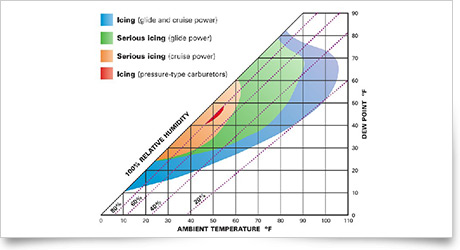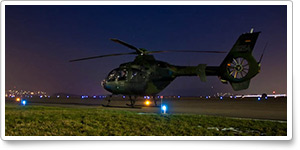|
|||||
Training TipsCharting the carb ice risk
Then, if a pilot doesn’t respond correctly by applying carburetor heat as the aircraft’s operating checklist recommends, the encounter can progress to a complete engine failure—and an off-airport landing.
Student pilots learn that under the right conditions, moist air passing through a float-type carburetor throat can chill below the freezing point, depositing ice that chokes off the flow of the fuel-air mixture. Student pilots also learn that generally, a high-risk temperature range is between 50 and 70 degrees Fahrenheit.
Accidents indicate that some pilots fail to recognize conditions conducive to carb ice formation, and its symptoms. But there’s no reason to be caught completely off-guard about the risk.
When accident investigators review conditions encountered by an aircraft that lost power in flight, one of the tools they use in determining an accident cause is a carburetor icing probability chart. Note how this valuable graphic illustrates that an increase in the air’s relative humidity elevates the carb-icing risk in two flight phases: cruise power and glide power. Note also how risk rises at higher ambient temperatures in both phases.
Just as important as knowing when carb ice is likely to form is the ability to recognize symptoms of icing’s onset.
“It is imperative for a pilot to recognize carburetor ice when it forms during flight because a loss of power, altitude, and/or airspeed will occur,” explains Chapter 6 of the Pilot’s Handbook of Aeronautical Knowledge. “These symptoms may sometimes be accompanied by vibration or engine roughness. Once a power loss is noticed, immediate action should be taken to eliminate ice already formed in the carburetor, and to prevent further ice formation. This is accomplished by applying full carburetor heat, which will cause a further reduction in power, and possibly engine roughness as melted ice goes through the engine.”
Applying carburetor heat can reduce power by as much as 15 percent. Strong evidence that ice was present is a gradual increase in power to an rpm or manifold-pressure value higher than just before heat was applied.
Start with the chart and avoid the carb ice hazard! Flight Training NewsFAA releases final ATP certification ruleThe FAA on July 10 released the final rule for the Pilot Certification and Qualification Requirements for Air Carrier Operations, which will require pilots to hold an air transport pilot certificate in order to fly for an air carrier. AOPA expressed its concern in the original notice of proposed rulemaking on the effect the rule will have on Part 61 flight training providers and new student pilot starts. Read more >> Be SAFE, get accident forgiveness at EAA AirVenturePilots and Starr Aviation policyholders who are planning to attend EAA AirVenture in late July can now get accident forgiveness while going through training with some of the best in the business. Starr has teamed up with the Society of Aviation and Flight Educators (SAFE) to entice attendees to take a minute away from the airshow and shop for a program to learn something new and get something back in the process. Read more >> AeroVelo wins Sikorsky Human Powered Helicopter CompetitionToronto-based AeroVelo Inc. has won the American Helicopter Society (AHS) International’s Igor I. Sikorsky Human Powered Helicopter Competition, which was established in 1980. The AHS International Human Powered Helicopter Competition committee thoroughly reviewed the design, data, and flight testing of AeroVelo’s Atlas human-powered helicopter, which flew on June 13. Read more >> Air Safety Institute materials used for Afghanistan ground schoolMaterials published by the Air Safety Institute are helping pilots in Afghanistan keep their skills sharp in the combat zone. Even though soldiers are in Afghanistan, the Department of Army Standardization still requires them to keep up their aviation skills. That is how ground school training materials from the AOPA Foundation’s Air Safety Institute ended up with Alpha Company 2/104th GSAB 2-104th General Support Aviation Battalion’s Task Force Phoenix at Bagram Airfield. Read more >> Five flight training appsNo matter what level you are in your flight training, the list of apps to help you continues to grow. This week, we look at five apps covering topics including references, maneuvers, and ground school. Read more >> Sikorsky launches Helicopter 2050 ChallengeSikorsky Aircraft has launched the 2013 Sikorsky Helicopter 2050 Challenge, a national competition that invites youths aged 9 through 16 to design a helicopter capable of addressing global issues likely to be encountered by mid-century. The winner of the grand prize—the Igor Sikorsky Youth Innovator Award—will receive a $1,000 scholarship, meet with Sikorsky rotorcraft engineers, and receive an expenses-paid tour of the Black Hawk and Seahawk helicopter assembly lines at the company’s Stratford, Conn., headquarters. University uses Asiana accident for safety trainingThe University of Dubuque’s aviation program, with about 170 flight students, is using the recent Asiana Airlines accident as a learning tool in the classroom, reports KWWL-TV. The school is using a CRJ200 flight simulator to help students get the flight hours they need before becoming airline pilots. UND Foundation makes donation to LA aircraft mechanics schoolThe University of North Dakota (UND) Aerospace Foundation has donated $25,000 to the Los Angeles Unified School District’s struggling aircraft mechanics school. The money will provide scholarships to low-income students preparing for jobs as airframe and powerplant mechanics. The school was under a threat of closure due to budget cuts. Training ResourcesRamp operationsKnowing what will keep you and your passengers safe is the key to conducting each flight safely. Because the ramp area can be full of hazards, educating yourself about some of the common dangers on the ramp will help you navigate to and from your aircraft without incident. This safety brief examines some of the things you can do to protect yourself, and your passengers, each and every time you go flying. Download the PDF >>
Did you know that student pilots who join AOPA are three times more likely to complete their flight training? Membership includes unlimited access to aviation information by phone (800/USA-AOPA, weekdays from 8:30 a.m. to 8 p.m. Eastern time) or from Flight Training Online or AOPA Online. If you’re not already a member, join today and get the pilot’s edge.
Medical petition update, DHS leadership vacuumAOPA President Craig Fuller wonders why a straightforward request that would save pilots and the government millions of dollars has taken more than a year (and counting) to draw any FAA response: The joint AOPA/Experimental Aircraft Association petition to allow pilots to fly many common four-seat aircraft with a driver’s license in lieu of a third class medical remains in limbo, and Fuller checks in with the latest. AOPA Live This Week also looks at how a leadership vacuum at the U.S. Department of Homeland Security is complicating efforts to correct a heavy-handed approach by federal agents searching GA aircraft; Rod Machado offers tips on how to eyeball a glidepath; and AOPA Live® will take you for a ride in a Diamond twin that just sips fuel. As of publication time, AOPA Live producers were finalizing this week's episode. Check back on the AOPA Live page for the latest edition that will be available July 19. Career PilotDelta to add 225 flight attendantsDelta Air Lines will hire 225 flight attendants later in 2013 and intends to hire even more during 2014. The airline is hiring cabin crew as it prepares to integrate 88 Boeing 717s, being phased out by Southwest Airlines subsidiary AirTran Airways, into its fleet, the Atlanta Journal-Constitution reported July 5. Delta will receive the first AirTran jets in September and will place them into service over the next few years, replacing 50-seat regional jets. Delta is not accepting applications, however. According to the newspaper report, new flight attendants will come from an existing pool of applicants. For more aviation career news, see the Flight Training website. Plane SpotterFlight of the ‘fenestron’: Eurocopter EC135
Training ProductsAircraft Spruce offers flight logThe Aero Products VFR-11 Flight Log offered by Aircraft Spruce simplifies navigation by providing for listing of intersections, radials, frequencies, clearances, and complete flight plan, along with a pad of 5-1/2-inch-by-8-1/2-inch sheets. The cost is $3.95. Gleim offers safe pilot courseThe Gleim Safe Pilot Course is a recurrent ground training course designed to increase pilots’ knowledge and abilities in regard to operating safely in the National Airspace System. The course covers recent aircraft accidents and highlights the causes of and lessons to be learned from these accidents. It also offers practical guidance on creating an emergency action plan. The cost is $29.95.
Note: Products listed have not been evaluated by ePilot editors unless otherwise noted. AOPA assumes no responsibility for products or services listed or for claims or actions by manufacturers or vendors. Member BenefitsAviate, navigate … don’t ever stop aviatingAs one of the counselors working daily with the members of the Legal Services Plan, Talbot Martin, an associate at Yodice Associates and a CFI, sees certain patterns emerge. In addition to patterns, he sees where law, policy, and flying skills meet safety. One of the most important patterns he has seen emerge relates to that old adage, “Aviate, navigate, communicate.” Read more >> What you should know about purchasing AD&D coveragePurchasing insurance typically is not on the top of the fun-to-do list, and it can seem like a complicated process. Here are some things you should know about accident insurance and the AOPA AD&D Protection Plan. With AOPA Accidental Death & Dismemberment Protection Plan, you’re protected anywhere, 24/7 coverage with aviation included. The guaranteed benefits cover general aviation pilots at all levels of flying, even student pilots. Read more >> BlogsJust ahead in the September issueFlight Training magazine is in final production on the September issue, but most of Technical Editor Jill Tallman’s thoughts are still stuck on the month of July—and EAA AirVenture. Be that as it may, here’s a glimpse of some of what you can expect to find when the magazine reaches your mailbox or electronic device. Read more >> An expensive reminder of the basicsPundits, bloggers, and all manner of experts/pseudo experts are holding forth on what happened or might have happened in the Asiana Boeing 777 accident at San Francisco. This accident serves as an expensive and tragic reminder about the importance of basics and why things are done in certain ways regarding aviation safety. Read more >> AOPA Career OpportunitiesEver dream of turning your passion for aviation into a career? We’re looking for an aircraft analyst, director of corporate partnerships, marketing specialist, software test and quality assurance analyst, and AOPA Live editor/graphic artist. To learn more about other AOPA career opportunities, visit AOPA Online. AVIATION EVENTS & WEATHER
|
||||||||||||||||||||||||||||||||





